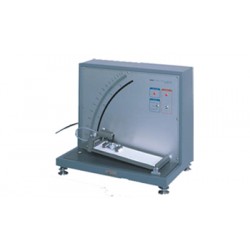Static coefficient of friction tester No.2088
The coefficient of friction on paper surface is one characteristic that provides a measurement for evaluating the paper surface condition. This tester helps easy measurement of the coefficient of static friction. It works as follows. A specimen is attached onto each of the inclined driving plate and the traveling weight. As the inclined driving plate gradually increases the inclination, the weight travels at a point where the inclination exceeds the limit of the friction range of the specimen. At that point, the sensor detects the motion and stops the inclined plate immediately. The coefficient of static friction is calculated from that inclination. As the scale markings represent values of the inclination(θ), convert into tanθ, you can directly read the value of the coeficient of static friction(µ)
Spesification
| Measurement range | scale of static friction coefficient 0 to 1.500 (minimum increment 0.005), sliding angle scale 0 to 550(minimum increment 0.50 ) |
| Inclined plate speed | 8 mm/sec. in measurement, 16 mm/sec. in return |
| Specimen size | specimen A 120x250 mm (maximum), specimen B 60x150 mm (contact surface) |
| Traveling weight | total 1000 g |
| Referential standards | JIS P-8147-1994, TAPPI T-815om-01 |
| Power source | 100/110 VAC 50/60 Hz 1 A |
| Outer dimensions | 470x290x410 mm |
| Instrument weight | 16 kg |
Inquiry
Video
Tidak ada video untuk produk ini




 Portable System
Portable System Integrated Online Monitoring
Integrated Online Monitoring Material Testing Machine
Material Testing Machine Vibration Sensor
Vibration Sensor Integrated Online Monitoring
Integrated Online Monitoring Portable System
Portable System Adhesive Testing
Adhesive Testing Boxes & Cartons
Boxes & Cartons Composite Films
Composite Films Films & Foils
Films & Foils Label
Label Alat Industri Sipil
Alat Industri Sipil Engine Industries
Engine Industries Food & Beverage Industries
Food & Beverage Industries Pharmacy Industries
Pharmacy Industries Paper Industries
Paper Industries Plastic Industries
Plastic Industries Power Industries
Power Industries Automotive Industries
Automotive Industries Electronic Industries
Electronic Industries Packaging Industries
Packaging Industries Manufacture Industries
Manufacture Industries Rubber Industries
Rubber Industries Oil and Gas Industries
Oil and Gas Industries Printing Testing Equipment
Printing Testing Equipment Jasa Kalibrasi Alat dan Mesin Jakarta
Jasa Kalibrasi Alat dan Mesin Jakarta NDT Portable System
NDT Portable System NDT Online Monitoring
NDT Online Monitoring Weather Station
Weather Station Data & Logger By Application
Data & Logger By Application Data & Logger By Performence
Data & Logger By Performence Data & Logger By HOBO
Data & Logger By HOBO Sensor Suhu
Sensor Suhu Sensor Jarak
Sensor Jarak Sensor Kecepatan
Sensor Kecepatan Sensor Tekanan
Sensor Tekanan Gaya Puntir
Gaya Puntir Gaya Tekan
Gaya Tekan Sensor Posisi
Sensor Posisi Sensor Optik
Sensor Optik Sensor Khusus
Sensor Khusus Sensor Warna
Sensor Warna Unit Pemrosesan Sinyal
Unit Pemrosesan Sinyal Pengukuran 2D/3D
Pengukuran 2D/3D Sensor Ketebalan
Sensor Ketebalan Sistem Inspeksi
Sistem Inspeksi









